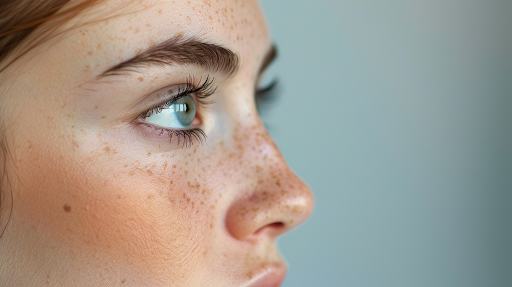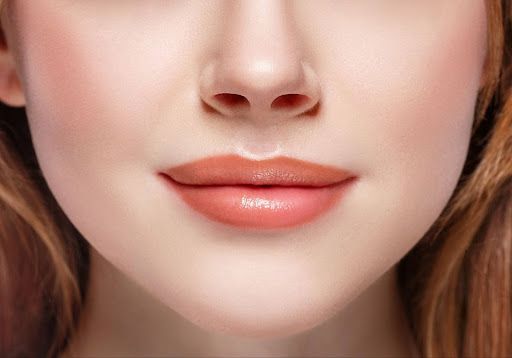What is textured skin?
Textured skin refers to a skin surface that is uneven or rough, rather than smooth and soft. This texture can be caused by a variety of factors including acne scars, enlarged pores, fine lines, and wrinkles, as well as skin conditions like keratosis pilaris, which results in small bumps on the skin. External factors like sun damage, lack of moisture, and buildup of dead skin cells due to insufficient exfoliation can also contribute to skin texture issues. Textured skin can affect anyone and may vary in severity and appearance across different areas of the skin.
If you’ve noticed your skin has uneven areas, you’ve probably tried at-home remedies such as acne treatments, anti-aging creams, top-rated face exfoliators, and more—yet these might have limited effects. Below, our experts offer their top advice for achieving a smoother, more even skin texture.
How to get rid of textured skin
To achieve a smoother skin texture, you can follow these steps which incorporate both skincare routines and lifestyle changes:
- Exfoliate Regularly: Exfoliating helps to remove dead skin cells that can contribute to uneven texture. Use a gentle exfoliator 2-3 times a week. Choose between chemical exfoliants, like AHAs (glycolic acid) and BHAs (salicylic acid), and physical exfoliants, like scrubs, depending on your skin type.
- Stay Hydrated: Drinking plenty of water and using hydrating skincare products like hyaluronic acid can help your skin appear smoother and plumper by maintaining proper moisture levels.
- Use Retinoids: Retinoids can promote cell turnover and improve skin texture. They are available in various forms, such as retinol (over-the-counter) and tretinoin (prescription), which can help reduce the appearance of fine lines, wrinkles, and uneven skin texture.
- Moisturize Effectively: Keeping your skin moisturized with the right type of moisturizer for your skin type can prevent dry patches and keep your skin smooth.
- Protect Your Skin from the Sun: Sun damage can worsen skin texture and lead to further irregularities. Always use a broad-spectrum sunscreen with an SPF of 30 or higher.
- Balanced Diet: Eating a diet rich in antioxidants, vitamins, and minerals supports skin health. Foods high in omega-3 fatty acids, such as fish, nuts, and seeds, can also improve skin’s texture.
- Professional Treatments: Consider professional treatments if home care isn’t enough. Chemical peels, microdermabrasion, and laser therapy are effective procedures that a dermatologist can perform to help smooth textured skin.
- Consult a Dermatologist: If you’re struggling with severe textured skin issues, consulting a dermatologist is advisable. They can provide tailored advice and treatments based on your specific skin condition.
Implementing these steps consistently should help in improving your textured skin over time.
Our non-surgical treatments can be highly effective for improving the textured skin, addressing issues such as scarring, fine lines, wrinkles, and overall roughness. Here are some of the top treatments available at medical spas that can help enhance your skin’s texture:
- Chemical Peels: These involve the application of a chemical solution to remove the top layers of skin, promoting the growth of new, smoother skin. Peels vary in strength and can be tailored to address specific skin concerns like age spots, acne scars, and sun damage.
- Laser Skin Resurfacing: Laser treatments can reduce wrinkles, scars, and hyperpigmentation by removing the outer layer of the skin and heating the underlying layers to stimulate collagen production. This results in smoother and firmer skin.
- Microneedling: Also known as collagen induction therapy, this procedure involves using fine needles to create tiny punctures in the top layer of the skin, which triggers the body to create new collagen and elastin. Microneedling is particularly effective for acne scars and can improve skin texture and firmness.
- Dermal Fillers: Although primarily used to fill wrinkles and add volume to the face, certain fillers can improve skin texture by stimulating collagen production beneath the skin’s surface.
- Platelet-Rich Plasma (PRP) Therapy: Often combined with microneedling, PRP involves using the patient’s own platelets to accelerate healing and regenerate skin cells, improving the texture and vitality of the skin.
See Before and After Patient Photos
Before deciding on any medical spa treatment, it’s crucial to consult with a qualified skincare professional or dermatologist. They can assess your skin type, discuss your concerns, and recommend the most suitable treatment to achieve the best results for smoother, healthier-looking skin.
What causes textured skin?
Rosacea
Rosacea is a chronic skin condition characterized by redness and visible blood vessels in the face. It may also produce small, red, pus-filled bumps. These symptoms can flare up for a period of weeks to months and then diminish for a while. Rosacea can occur in anyone but is most common in middle-aged women with fair skin.
Dry Skin
Dry skin is a common condition that can contribute to a range of textured skin issues, impacting both the feel and appearance of your skin. Unlike oily skin, which is characterized by excess sebum production, dry skin lacks sufficient natural oils, leading to a rough, flaky, or itchy appearance. This can result in an uneven textured skin, making the skin’s surface appear less smooth and more patchy or cracked.
Acne scars
Acne scars can leave the skin feeling rough and looking uneven, often resulting in bumpy skin, rough patches, and an uneven skin tone. These scars occur when clogged pores, inflamed with excess oil, dead skin cells, and bacteria, lead to permanent textural changes in the skin. For individuals aiming for smooth skin, treatments containing lactic acid can be particularly beneficial.
Lactic acid, an alpha hydroxy acid, gently exfoliates the top layer of the skin, reducing the appearance of scars and promoting a more even complexion. However, those with sensitive skin should use lactic acid with caution and consider consulting a dermatologist to tailor a treatment plan that safely addresses both acne scars and skin sensitivity.
Fine lines and wrinkles
Fine lines and wrinkles are common signs of aging that reflect changes in textured skin and elasticity. Over time, the skin loses collagen and elastin, leading to increased skin laxity and the formation of lines and creases. These issues are often accompanied by other texture concerns such as rough skin, uneven texture, and the buildup of dead cells. Although not directly related to aging skin, conditions like keratosis pilaris, characterized by bumpy skin due to excess keratin blocking hair follicles, can exacerbate the appearance of uneven textured skin.
Addressing these multifaceted skin concerns involves maintaining healthy skin through proper hydration, regular exfoliation to remove dead cells, and targeted treatments that enhance skin’s elasticity and smoothness. By nurturing skin health and addressing specific texture issues, one can minimize the appearance of fine lines and wrinkles and maintain a more youthful, even complexion.
Sun damage
Sun damage is a significant factor in many common skin concerns, including flaky skin, bumpy skin, and the appearance of dark spots. Prolonged exposure to UV rays can disrupt the normal texture and pigmentation of the skin, leading to a rough, uneven surface and accelerated signs of aging. Dark spots, often referred to as age spots or sunspots, are patches of hyperpigmentation that occur as a direct result of sun exposure.
These spots are particularly common in areas frequently exposed to sunlight, such as the face, hands, and arms. Protecting the skin from UV damage with broad-spectrum sunscreen, wearing protective clothing, and seeking shade are crucial steps in preventing these changes. Additionally, incorporating skincare products that promote hydration and skin renewal can help to manage and repair some of the damage, leading to a smoother and more even complexion.
How to prevent textured skin
Textured skin, often manifesting as scaly, flaky, or uneven skin, can detract from your complexion’s radiance and smoothness. Preventing and managing textured skin involves a multifaceted skincare approach, addressing everything from pore size to the production of collagen. Here are some strategies to avoid textured skin and maintain a smooth and radiant skin over time, using effective ingredients and professional advice:
1. Strengthen the Skin Barrier
A robust skin barrier is crucial in preventing irritated skin and maintaining overall skin health. Incorporate products that contain ceramides, fatty acids, and cholesterol to help repair and strengthen the skin barrier, thus preventing issues related to acne-prone and sensitive skin.
2. Regular Exfoliation
Removing dead skin cells is essential for preventing buildup that leads to textured skin. Use a chemical exfoliator containing AHAs (like glycolic acid) or BHAs (like salicylic acid). These help in reducing enlarged pores and clearing flaky skin without the harshness that physical scrubs can impose on your skin.
3. Vitamin C
Incorporating Vitamin C into your skincare routine can boost the production of collagen, vital for maintaining skin elasticity and preventing loose skin. Vitamin C also helps in achieving radiant skin by brightening the complexion and reducing signs of aging.
4. Consult a Cosmetic Dermatologist
For persistent skin issues like deeply textured skin or significantly enlarged pores, consulting a cosmetic dermatologist can provide tailored solutions. Treatments may include professional chemical peels or laser therapy, which are effective in resurfacing the skin and improving texture.
5. Choose Suitable Products for Combination Skin
If you have combination skin, selecting products specifically designed for your skin type is crucial. Look for non-comedogenic formulations that balance moisture levels without exacerbating oil production, which can contribute to textured skin.
6. Hydrate and Protect
Hydrated skin is less prone to flaky skin and other textural irregularities. Ensure you’re drinking plenty of water and using hydrating skincare products. Additionally, protect your skin from sun damage with a broad-spectrum sunscreen, as UV exposure can degrade collagen and lead to textured skin over time.
7. Manage Pore Size
To manage pore size and prevent the appearance of enlarged pores, integrate niacinamide into your skincare regimen. This ingredient is known for its ability to regulate oil production and improve the skin’s overall texture.
8. Regular Skincare Routine
Adherence to a regular skincare routine is fundamental. Ensure your routine covers all bases—cleansing, exfoliating, moisturizing, and protecting. This consistency is key to maintaining smooth, radiant skin and preventing the accumulation of dead skin cells and other impurities.
By integrating these practices into your skincare routine, you can help prevent and manage textured skin, keeping your complexion smooth and radiant. Remember, patience and consistency are key in seeing tangible results in your skin’s texture.
For anyone striving for flawless skin, especially those dealing with acne-prone skin, scaly skin, or bumpy skin texture, understanding when and how to seek professional help can be a game changer. Integrating the expertise of a board-certified dermatologist can transform your skin care routine and significantly improve your skin’s appearance and health. Here’s how a dermatologist can help enhance the natural healing process, promote cell turnover, and guide you towards smoother, brighter skin.
Understanding the Role of a Board-Certified Dermatologist
A board-certified dermatologist is an expert in skin health, trained to diagnose and treat over 3,000 conditions affecting the skin, hair, and nails. For those with poor skin texture or chronic skin issues like acne, consulting with a dermatologist is crucial. These professionals use evidence-based treatments to address both the symptoms and underlying causes of skin conditions.
Focusing on Cell Turnover and Cell Renewal
One of the key factors a dermatologist might address is cell turnover and cell renewal. Acne-prone skin, in particular, can benefit from enhanced cell turnover, which helps to clear pores and reduce the severity of breakouts. Dermatologists might prescribe retinoids or other topical agents that speed up cell renewal to help achieve a smoother texture and more even skin tone.
The Impact of Physical Exfoliation
While physical exfoliation can be effective for removing dead skin cells, it can sometimes be too harsh for sensitive or damaged skin, leading to more harm than good. A dermatologist can provide guidance on the appropriate methods of exfoliation that won’t disrupt your skin’s natural healing processes. They can recommend safer alternatives, such as chemical exfoliants, that encourage cell renewal without causing additional irritation.
Achieving Brighter and Smoother Skin
For those dreaming of brighter and smoother skin, dermatologists can offer treatments that are not typically available over the counter. These might include professional chemical peels, microdermabrasion, or laser therapy, which can dramatically improve skin texture and tone. These procedures, under the guidance of a dermatologist, are tailored to match the specific needs of your skin, ensuring safety and effectiveness.
Long-term Management for Flawless Skin
Achieving flawless skin isn’t just about addressing current issues; it’s also about preventative care. A dermatologist can develop a comprehensive skincare regimen that suits your specific skin type and concerns, preventing future problems and maintaining the skin’s overall health. Regular check-ups ensure that the skincare regimen evolves as your skin does, adapting to changes and seasonal shifts.
In summary, for individuals battling with issues like acne-prone skin, scaly skin, or generally poor skin texture, seeking help from a board-certified dermatologist is essential. Their expertise in enhancing cell turnover, advising on proper exfoliation techniques, and providing advanced treatments leads to healthier, brighter, and more resilient skin.












